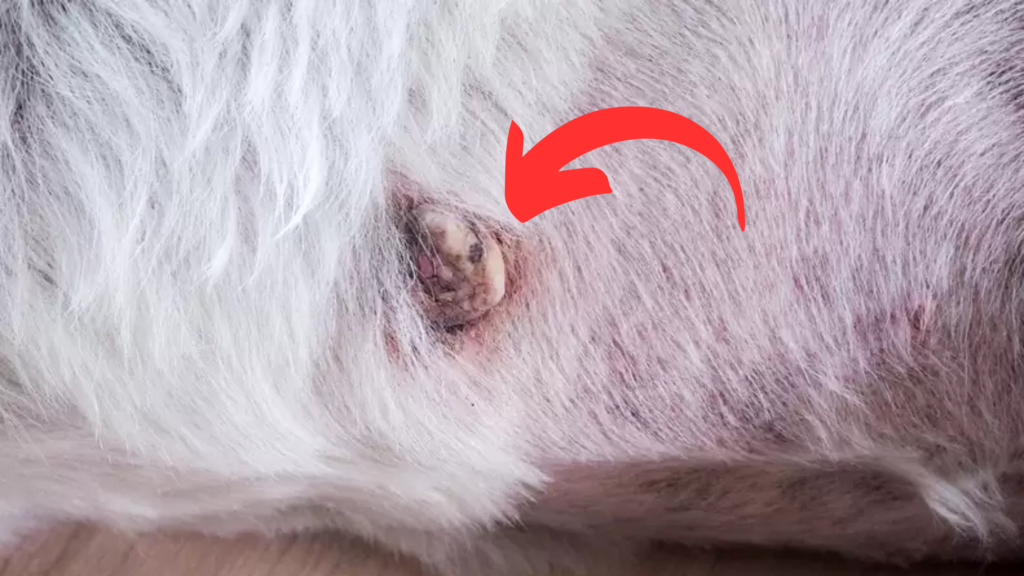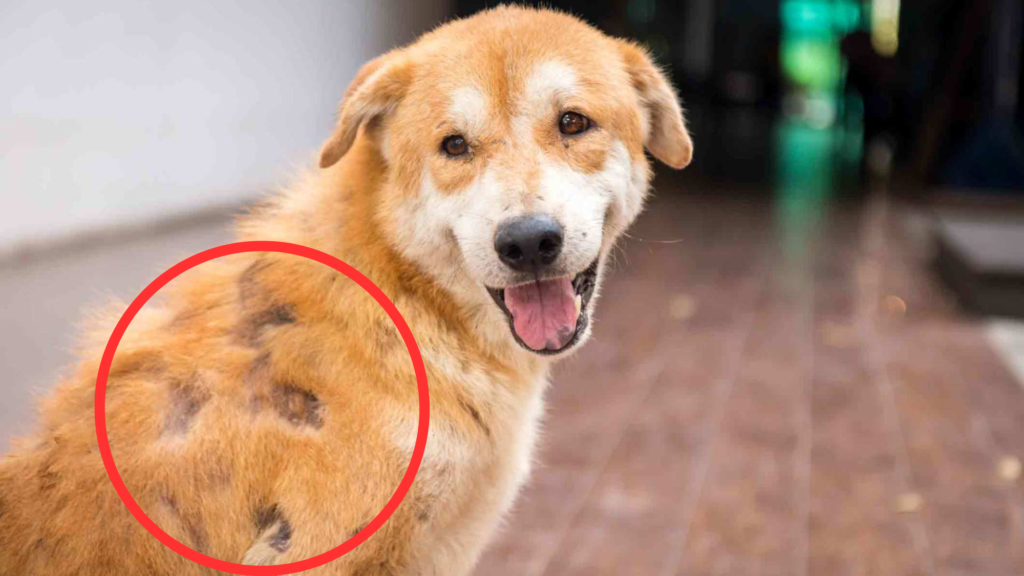| Summary: Dog skin tag vs cancer: Dog skin tags are soft, benign growths with a narrow base, while cancerous lumps may be irregular, firm, rapidly growing, or ulcerated. Warning signs include bleeding, color changes, and inflammation. A vet examination, biopsy, or fine-needle aspiration helps determine malignancy. Early detection ensures timely treatment and better health outcomes. |
Not every skin growth on your dog is a cause for alarm. While skin tags are generally benign, skin cancer can be life-threatening if not detected early. I will break down the differences between dog skin tag vs cancer lesions—from appearance and causes to diagnosis and treatment options—helping you make informed decisions about your pet’s health.
Skin tags are usually benign, soft growths, while cancerous lumps can be irregular, firm, or fast-growing. GPS dog collars can help track your pet’s activity to monitor any changes in behavior due to discomfort. The American Staffordshire Terrier’s coat type is short, sleek, and easy to maintain with regular brushing.
Blog Highlights
ToggleDog Skin Tag vs Cancer: Quick Comparison Table
| Factor | Skin Tag | Skin Cancer |
| Nature | Benign, non-cancerous growth | Malignant or pre-malignant lesion, may spread |
| Appearance | Small, soft, flesh-colored or slightly pigmented; may hang off the skin | Irregular shape, may be ulcerated, raised, or discolored; variable texture |
| Growth Rate | Slow-growing, usually remains stable over time | May grow rapidly or change in size, shape, or color |
| Common Locations | Around the neck, shoulders, or areas with loose skin | Anywhere on the body; common on sun-exposed or previously injured areas |
| Symptoms | Typically asymptomatic; not painful or irritating | May be itchy, bleed, or cause discomfort; can lead to systemic effects |
| Treatment | Often unnecessary; removal if irritated or for cosmetic reasons | Requires prompt veterinary evaluation; treatment may include surgery, radiation, or chemotherapy |
| Risk Factors | Often age-related, benign genetic predisposition | UV exposure, chronic inflammation, certain breeds predisposed |
1. Introduction: Understanding Skin Growths in Dogs
Skin abnormalities are common in dogs, and owners often worry when they notice small growths on their pet’s skin. While many of these growths are harmless skin tags, others can be indicators of more serious conditions such as skin cancer. Distinguishing between benign and malignant lesions is crucial for timely intervention and effective treatment. Cancerous tumors may ulcerate, bleed, or grow rapidly, whereas skin tags remain stable in size. Pet tech products like pet health monitors can help detect unusual changes early.
In this guide, we explore the characteristics of dog skin tags versus skin cancer. We discuss what these growths look like, their causes, risk factors, and the appropriate steps to take if you spot a suspicious lesion on your pet. Early detection and proper diagnosis are key to ensuring your dog leads a healthy, comfortable life.
2. What Are Skin Tags?

Characteristics of Skin Tags
Skin tags are small, benign, and usually painless growths that appear on the surface of your dog’s skin. They are generally soft, hang off the skin by a narrow stalk, and are often the same color as the surrounding skin or slightly pigmented. Here are some defining features:
- Size and Texture: Skin tags are typically small—ranging from a few millimeters to about a centimeter in diameter. They feel soft and pliable.
- Location: Commonly found in areas with skin folds or where the skin rubs against itself, such as around the neck, under the arms, or near the ears.
- Growth Pattern: They tend to appear gradually over time and do not usually change in size or appearance rapidly.
- Symptoms: Generally, skin tags cause no discomfort. However, if a skin tag becomes irritated (due to rubbing or chewing), it might cause mild inflammation or itching.
Causes and Risk Factors for Skin Tags
Skin tags are most often associated with aging, genetics, and friction. Some dogs may be predisposed to developing these benign growths simply due to their breed or genetic makeup. While they do not pose a health risk, they can be unsightly or cause irritation if caught on clothing or bedding.
The best collar size for an American Staffordshire Terrier ensures a comfortable and secure fit for your dog during walks and training.
3. Understanding Skin Cancer in Dogs

Types of Skin Cancer in Dogs
Unlike benign skin tags, skin cancer in dogs represents a serious health condition that requires immediate attention. Several types of skin cancer can affect dogs, including:
- Mast Cell Tumors: These are among the most common skin cancers in dogs. They can appear as raised, sometimes ulcerated lesions and may vary in color.
- Melanomas: Often darkly pigmented, melanomas can be benign or malignant depending on their location and cellular behavior.
- Squamous Cell Carcinoma: Typically seen in areas exposed to the sun, these cancers can present as crusty, ulcerated lesions that may bleed.
- Fibrosarcoma: This type can develop as a firm, rapidly growing mass and may infiltrate surrounding tissues.
If a lump changes in color, shape, or size, it’s best to consult a vet for a biopsy. Electronic dog collars can prevent excessive scratching or irritation of the lump.
Characteristics of Malignant Lesions
Skin cancers in dogs usually have distinct features that set them apart from benign skin tags:
- Irregular Appearance: Unlike the uniform, soft texture of skin tags, cancerous lesions may be uneven, raised, or ulcerated.
- Rapid Change: A key warning sign is a lesion that grows quickly or changes in color, shape, or size.
- Location: Skin cancers can appear anywhere on the body but are often found on areas exposed to the sun, previously injured sites, or regions with less fur coverage.
- Symptoms: Malignant lesions may cause discomfort, itchiness, or even bleeding. In advanced cases, they might lead to systemic symptoms like lethargy or weight loss.
Risk Factors for Skin Cancer
Several factors can increase the risk of skin cancer in dogs:

- UV Exposure: Prolonged exposure to sunlight, especially for dogs with light-colored or thin coats, can elevate the risk.
- Chronic Inflammation: Repeated skin injuries or infections can lead to changes in skin cells.
- Genetic Predisposition: Certain breeds are more prone to developing specific types of skin cancer.
- Age: Older dogs are more susceptible, as the risk of cellular mutations increases with age.
To find out the what size collar for an Affenpinscher, ensure you measure your dog’s neck correctly for a perfect fit.
4. Comparing Appearance: Skin Tag vs. Cancer
Visual differences can often help differentiate between a benign skin tag and a potentially malignant lesion. Here’s a closer look:
- Skin Tag:
- Appearance: Small, soft, and often pedunculated (attached by a small stalk).
- Color: Usually matches the surrounding skin or is slightly darker.
- Borders: Well-defined and smooth edges.
- Growth: Typically static, with little to no change over time.
- Skin Cancer:
- Appearance: May be irregular in shape, with rough or ulcerated surfaces.
- Color: Can be multi-colored (e.g., a mix of brown, black, red, or even white).
- Borders: Often indistinct or irregular edges.
- Growth: May increase in size, change shape, or bleed, indicating an active and potentially aggressive process.
5. Diagnosis: When to Seek Veterinary Advice

Determining whether a skin growth is a harmless skin tag or a sign of cancer requires professional evaluation. Here’s what you need to know:
Visual Examination and History
- Initial Observation: Start by monitoring the growth for any changes in size, shape, or color. Note if your dog shows signs of discomfort or if the lesion becomes inflamed.
- Behavioral Clues: Changes in your dog’s behavior—such as increased scratching, licking, or reluctance to be touched in a specific area—can be a sign of irritation or pain.
Veterinary Evaluation
- Physical Examination: A veterinarian will perform a thorough physical exam, paying close attention to the lesion’s characteristics.
- Biopsy: For suspicious growths, a biopsy is often necessary. This procedure involves taking a small tissue sample from the lesion for microscopic examination. It is the most definitive way to diagnose cancer.
- Additional Tests: Depending on the type and location of the lesion, your vet might recommend blood tests or imaging studies (like X-rays) to determine if the cancer has spread.
Early diagnosis is critical in managing skin cancer effectively. If you notice any unusual growths or changes in your dog’s skin, it’s important to consult your veterinarian promptly.
6. Treatment Options: Managing Skin Tags and Skin Cancer
Treating Skin Tags
In many cases, skin tags do not require treatment. They are benign and can be left alone unless they cause irritation or are cosmetically undesirable. However, if removal is necessary:
- Surgical Excision: Your vet can remove the skin tag under local anesthesia. This is a simple procedure with minimal recovery time.
- Cryotherapy: In some cases, freezing the tag with liquid nitrogen is an option.
- Monitoring: If the skin tag is not causing problems, regular monitoring may be all that’s required.
Treating Skin Cancer
Treatment for skin cancer depends on the type, location, and stage of the tumor. Options may include:
- Surgical Removal: The primary treatment for many skin cancers. Complete excision of the tumor is often the goal to prevent recurrence.
- Radiation Therapy: Used either as a primary treatment or adjunct to surgery, especially for tumors that are difficult to remove completely.
- Chemotherapy: Systemic or localized chemotherapy may be recommended for aggressive or metastatic cancers.
- Immunotherapy: In some cases, newer immunotherapeutic agents can help the body fight off cancer cells.
- Palliative Care: For advanced cases, treatment may focus on managing symptoms and improving quality of life rather than complete cure.
Deciding on the appropriate treatment requires a detailed discussion with your veterinarian or a veterinary oncologist. Routine skin checks can help differentiate harmless tags from potential tumors. Dog training equipment can aid in keeping your dog still during examinations.
Explore the best dog collars for French Bulldogs to keep them comfortable while ensuring durability and style.
7. Prognosis and Long-Term Management
Prognosis for Skin Tags
Skin tags, being benign, generally have an excellent prognosis. They do not spread or cause systemic problems. However, periodic checks are advisable to ensure that there are no changes over time.
Prognosis for Skin Cancer
The outlook for dogs with skin cancer depends on several factors, including the type of cancer, its location, and how early it is detected. Generally:
- Early Detection: When caught early, many forms of skin cancer can be effectively treated with surgery, leading to a good prognosis.
- Aggressive Cancers: Some cancers, like certain mast cell tumors, may have a more guarded prognosis and require aggressive treatment.
- Ongoing Monitoring: After treatment, regular veterinary check-ups are essential to monitor for recurrence or the appearance of new lesions.
8. Preventative Measures and Monitoring
Preventative Care for Skin Tags

While skin tags are benign, taking care of your dog’s skin can help prevent irritation and potential complications:
- Regular Grooming: Keeping your dog well-groomed can reduce friction and prevent skin tags from becoming irritated.
- Healthy Diet: A balanced diet rich in omega fatty acids, vitamins, and antioxidants promotes overall skin health.
- Routine Check-Ups: Regular veterinary visits help monitor skin changes and catch any abnormalities early.
Preventing Skin Cancer
While not all cases of skin cancer are preventable, certain measures can reduce the risk:
- Sun Protection: Limit exposure to direct sunlight, especially for dogs with light-colored or thin coats. Dog-safe sunscreens and protective clothing can be beneficial.
- Avoiding Irritants: Minimize exposure to chemicals or irritants that can cause chronic skin inflammation.
- Early Detection: Regularly inspect your dog’s skin for new or changing lesions, especially if they spend a lot of time outdoors.
- Vaccination and Health Maintenance: Keep your dog’s overall health in check through proper nutrition, exercise, and routine vaccinations, as a strong immune system can help combat abnormal cell growth.
9. Practical Tips for Dog Owners
Recognizing Changes
- Monitor Growths: Keep an eye on any skin tags or lesions. Take note of changes in size, color, or texture.
- Document and Compare: Use photographs over time to track any changes. This can help your vet make a more accurate diagnosis.
- Behavioral Observations: Pay attention if your dog starts to scratch more than usual, shows signs of discomfort, or avoids being touched in certain areas.
When to Seek Veterinary Advice
- Immediate Action: If you notice rapid changes or if a lesion appears to bleed or ulcerate, consult your veterinarian immediately.
- Regular Check-Ups: Include skin examinations as part of your dog’s routine wellness visits.
- Professional Evaluation: Don’t hesitate to ask your vet for a biopsy if a growth seems suspicious. Early diagnosis is key.
Managing Anxiety and Discomfort
- Comfort Measures: If your dog is uncomfortable due to a skin growth, your veterinarian might suggest treatments to reduce irritation while awaiting further evaluation.
- Supportive Care: Supplements or dietary changes that promote skin health can sometimes help reduce inflammation and support healing.
Find the best dog collars for Dachshunds that accommodate their long bodies and prevent strain on their necks.
Final Verdict:
Differentiating between dog skin tag vs cancer lesion is vital for your dog’s health. While skin tags are generally harmless and often require little more than periodic observation, skin cancer demands prompt veterinary intervention. By understanding the differences in appearance, growth patterns, and associated symptoms, you can take the right steps to ensure your dog receives the necessary care.
- For Benign Skin Tags: Monitor them regularly and consult your veterinarian if you notice any changes or signs of irritation.
- For Suspected Skin Cancer: Early intervention is crucial. Seek a professional diagnosis and discuss treatment options tailored to your dog’s specific condition.
Your proactive approach and regular veterinary check-ups can make all the difference in managing your dog’s skin health.
Get insights into what is best for Dachshunds: a collar or harness for their safety, comfort, and health during walks.





